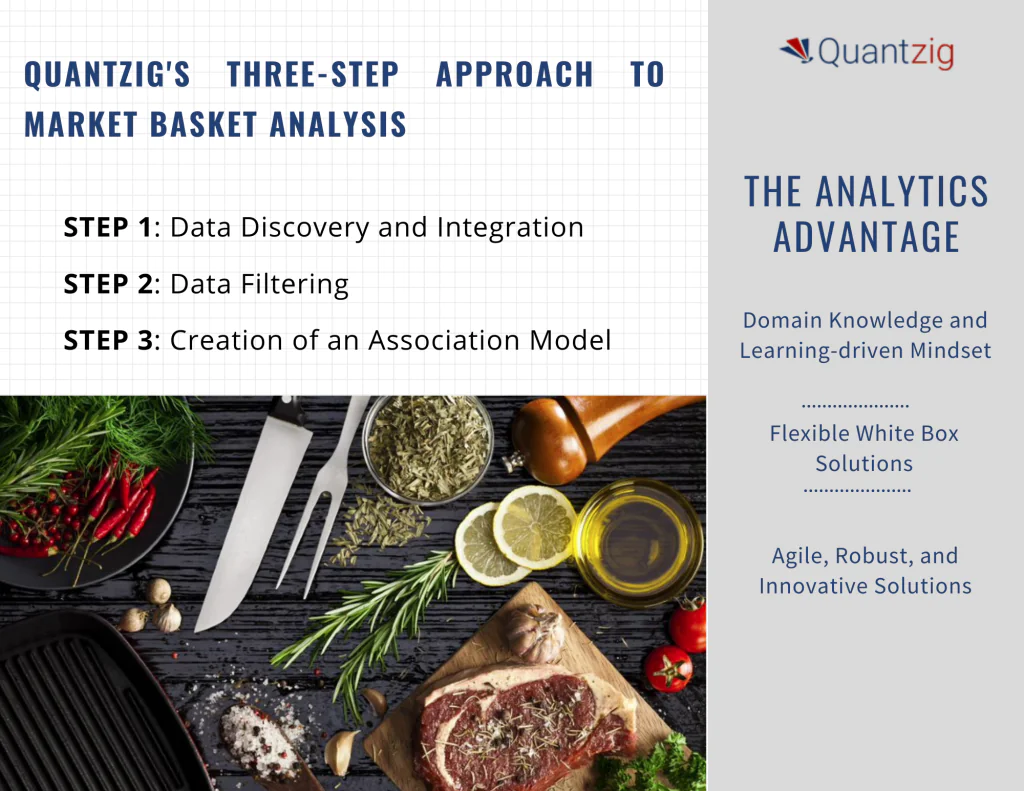Table of Contents
What You’ll Find in this Case Study:
- Market Basket Analysis Engagement Summary
- How Can Retailers Benefit from Market Basket Analysis?
- Quantzig’s Approach
- Step 1: Data Discovery and Integration
- Step 2: Data Filtering
- Step 3: Creation of an Association Model Using Market Basket Analysis
- Market Basket Analysis Services Outcome
Market Basket Analysis Engagement Summary
We worked with a leading European specialty foods retailer, to build a market basket analysis solution using their existing BI platform. With the help of market analysis, the specialty foods retailer was able to increase the effectiveness of their marketing campaigns and optimize the layout of their stores to increase sales & profitability across its retail outlets.
How Can Retailers Benefit from Market Basket Analysis?
Customer acquisition, as we know, is a crucial factor that determines the success or failure of a company in today’s highly fragmented retail landscape. Due to many such factors that curtail growth, the retail sector is fraught with challenges ranging from data management to technology adoption which has made it necessary for businesses to find a solution that can address the specific requirements of its customers and enhance marketing effectiveness.
With our analytics experts for comprehensive insights on how we can help you,
Request a free proposalTo thrive in such a scenario, retailers must gain a better understanding of customer preferences and purchase patterns to offer better services and drive retention. Advanced analytics tools and data modeling techniques can help companies do so by helping them analyze customer data sets in real-time. Market analysis is one such technique that offers unprecedented insights into large datasets including- purchase history, information on product categories, and frequency of purchase. Using market analysis retailers can uncover relationships between different product categories and build targeted campaigns to generate new revenue.
The client- a specialty foods retailer based out of Denmark had invested heavily in CRM tools and customer data management techniques, but the deployed system failed to analyze data and extract important information from their vast customer and product databases. Though they were aware of the fact that details on customer preferences and purchase patterns could be obtained from a detailed analysis of transactional datasets that exist within the POS (Point of Sale) systems, lacked the analytics capabilities to decipher data sets and draw conclusive insights.
This is when they approached Quantzig and were looking at leveraging market analysis to drive marketing effectiveness and campaign success rates. The specialty foods retailer needed help with collecting and analyzing diverse data sets to extract actionable information from customer purchase patterns and disseminate those insights across the organization to enable C-suite executives and marketers to make the right decisions.
To sustain a competitive edge in today’s retail sector is not just challenging but close to impossible for new market entrants owing to the developments and technological advancements within the industry. In such a scenario, it’s crucial to up your game using analytics. To learn how market analysis can help,
Request a free pilotQuantzig’s Approach
Based on the clients’ existing tools and data management techniques, our market analysis experts developed a customized market analysis based solution to address their challenges and identify new areas to drive growth.
We adopted a three-step approach that comprised of the following phases:
Step 1: Data Discovery and Integration
To identify associations between purchases, its first essential for retailers to analyze data sets by collating data sets obtained from various sources. The first phase of this market basket analysis engagement revolved around data discovery and integration to identify correlations by analyzing data sets.
Step 2: Data Filtering
The second phase of this market analysis engagement revolved around cleansing and filtering customer data sets using advanced algorithms and data filtering techniques.
Step 3: Creation of an Association Model Using Market Basket Analysis
The final phase of this market basket analysis study focused on the creation of an association model and market basket analysis dashboard for the real-time data discovery and generation of recommendations on product bundling.
Business Outcome
Leveraging market basket analysis helped the client to make faster and well-informed decisions by empowering them to:
- Discover and analyze large volumes of POS data
- Enrich data sets from disparate sources into a single, unified view
- Deep dive into product affinities within a market basket
- Deploy a market basket analysis dashboard to quickly identify product affinities across the assortment
- Achieve a 3.5x increase in ROAS
Types of market basket analysis
Market basket analysis, a data mining technique used in retail and e-commerce industries, aims to uncover patterns of co-occurrence among items purchased by customers. It helps retailers understand the relationships between products and identify potential cross-selling or upselling opportunities. There are several types of market basket analysis techniques:
1. Association Rule Mining: This is the most common type of market basket analysis. It involves identifying rules that describe the likelihood of items being purchased together. The rules are typically in the form of “if {item A} is purchased, then {item B} is also likely to be purchased.” Apriori and FP-growth are popular algorithms used for association rule mining.
2. Sequential Pattern Mining: This type of analysis identifies sequences of items purchased together over time. It helps retailers understand the sequential order in which items are typically purchased. Sequential pattern mining algorithms, such as GSP (Generalized Sequential Pattern) and SPAM (Sequential Pattern Mining), are used for this purpose.
3. Sequential Rule Mining: Similar to sequential pattern mining, sequential rule mining identifies rules that describe the likelihood of sequences of items being purchased together. However, it also considers the time interval between purchases, providing more detailed insights into customer purchasing behavior.
4. Market Basket Clustering: This technique involves clustering customers based on their purchasing behavior. It helps retailers identify groups of customers with similar purchasing patterns and tailor marketing strategies accordingly. Clustering algorithms like K-means and hierarchical clustering are commonly used for market basket clustering.
5. Graph-Based Approaches: Graph-based approaches represent transactions as a graph, where items are nodes and transactions are edges. Graph mining techniques are then used to identify frequent patterns or communities of items within the graph.
6. Deep Learning-Based Approaches: Recently, deep learning techniques, such as neural networks, have been applied to market basket analysis. These approaches can handle large-scale datasets and complex patterns but require significant computational resources and data.
What is the benefit of market basket analysis?
Market basket analysis, a data mining technique often used in the retail industry, particularly in supermarkets and e-commerce platforms, leverages Machine Learning algorithms to analyze large datasets of customer purchase histories and product groupings. By identifying customer purchasing patterns, Market Basket Analysis (MBA) provides several benefits, including:
1. Predictive Market Basket Analysis: By understanding past purchasing behavior, businesses can predict future purchases and tailor their marketing strategies accordingly.
2. Differential Market Basket Analysis: Allows businesses to compare the purchasing patterns of different customer segments, helping in targeted marketing efforts.
3. Improved Customer Experience: By offering personalized product recommendations and promotions based on individual purchase histories, customer engagement and satisfaction can be enhanced.
4. Identifying Customer Behavior: MBA helps in understanding customer behavior, preferences, and trends, which in turn aids in improving customer experience and tailoring products or services accordingly.
5. Sales Increase: Through selective marketing and tailored product recommendations, businesses can increase sales by promoting items that are frequently purchased together or targeting customers with personalized promotions.
6. Demand Forecasting: By analyzing historical purchase data, businesses can forecast demand for products and adjust their inventory levels accordingly, reducing stockouts and overstock situations.
7. Competitor Analysis: MBA can also be used to analyze competitors’ product offerings and customer purchasing patterns, providing insights for strategic decision-making.
8. Seasonal Trends and Regional Market Dynamics: MBA helps in identifying seasonal trends and regional variations in purchasing behavior, enabling businesses to adapt their marketing strategies accordingly.
9. Return on Investment (RoI): By utilizing MBA to optimize marketing efforts and improve customer engagement, businesses can achieve a higher return on their marketing investments.
Overall, market basket analysis utilizing Machine Learning techniques offers significant advantages in understanding customer behavior, improving customer experience, and optimizing marketing strategies to drive sales and enhance profitability in the retail and e-commerce sectors.
Application of market basket analysis
Market Basket Analysis (MBA) finds applications in retail, e-commerce, and beyond. It enables businesses to optimize product recommendations, manage inventory effectively, and design targeted promotions. MBA aids in cross-selling and upselling, enhances customer segmentation for personalized marketing, and streamlines supply chain operations. Moreover, it facilitates fraud detection in finance, content recommendation in media, and menu optimization in the restaurant industry. By analyzing purchase patterns, MBA empowers businesses to make data-driven decisions, improve customer satisfaction, and drive profitability across diverse sectors.



